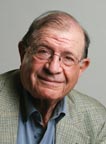Ivan P. Kaminow: Difference between revisions
(Created page with "== Biography == Considered a luminary in the field of photonics, Ivan Paul Kaminow’s contributions to lightwave technology have revolutionized telecommunications. Dr. Kaminow...") |
|||
| (3 intermediate revisions by 2 users not shown) | |||
| Line 1: | Line 1: | ||
== Biography == | == Biography == | ||
[[Image:Kaminow.jpg|thumb|right]] | |||
Considered a luminary in the field of photonics, Ivan Paul Kaminow’s contributions to lightwave technology have revolutionized telecommunications. Dr. Kaminow explored electro-optic materials for high-speed modulation of optical signals and developed a titanium-diffused waveguide for lightwave communications at microwave frequencies up to 100 GHz. This modulator is the technology of choice for today’s long-distance broadband lightwave systems. He also demonstrated the distributed Bragg reflector (DBR) laser and the ridge-waveguide structure for [[Semiconductor Laser|semiconductor lasers]] at telecommunications wavelengths. These devices are found in many of today’s commercial lightwave systems. As a research manager at [[Bell Labs]], Dr. Kaminow led the research in wavelength division multiplexed (WDM) optical communications. Its low cost and huge information capacity has made the commercial Internet a reality. | |||
[[Category:Lasers]] | An [[IEEE Fellow Grade History|IEEE Life Fellow]], Dr. Kaminow is currently a professor in the Electrical Engineering and Computer Science Department at the University of California, Berkeley, where he mentors graduate students in the field. In 2013 he was awarded the [[IEEE Edison Medal|IEEE Edison Medal]] “For pioneering, life-long contributions to and leadership in photonic devices and | ||
[[Category:Photonics]] | networks instrumental to global high-capacity optical networks.” | ||
[[Category:Lasers|Kaminow]] [[Category:Photonics|Kaminow]] | |||
Revision as of 14:24, 19 June 2013
Biography
Considered a luminary in the field of photonics, Ivan Paul Kaminow’s contributions to lightwave technology have revolutionized telecommunications. Dr. Kaminow explored electro-optic materials for high-speed modulation of optical signals and developed a titanium-diffused waveguide for lightwave communications at microwave frequencies up to 100 GHz. This modulator is the technology of choice for today’s long-distance broadband lightwave systems. He also demonstrated the distributed Bragg reflector (DBR) laser and the ridge-waveguide structure for semiconductor lasers at telecommunications wavelengths. These devices are found in many of today’s commercial lightwave systems. As a research manager at Bell Labs, Dr. Kaminow led the research in wavelength division multiplexed (WDM) optical communications. Its low cost and huge information capacity has made the commercial Internet a reality.
An IEEE Life Fellow, Dr. Kaminow is currently a professor in the Electrical Engineering and Computer Science Department at the University of California, Berkeley, where he mentors graduate students in the field. In 2013 he was awarded the IEEE Edison Medal “For pioneering, life-long contributions to and leadership in photonic devices and networks instrumental to global high-capacity optical networks.”
